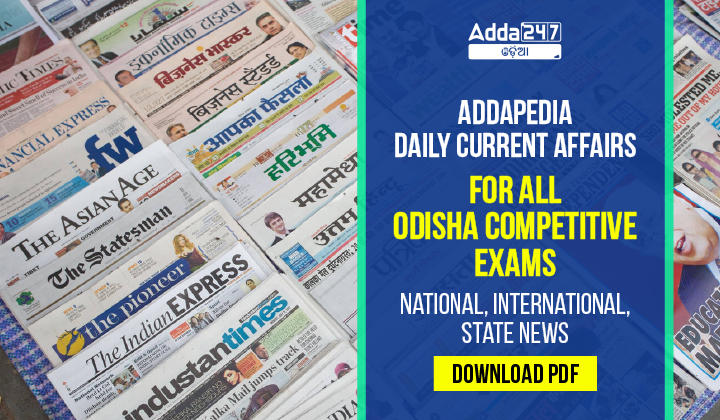As you are aware, in all competitive exams, the “Daily Current Affairs Section” holds significant importance in determining the cutoff scores. Therefore, if you excel in this section, you will have a better chance of achieving higher marks in these exams and securing a spot on the merit list.
Addapedia Odisha – Daily Current Affairs – 10 April 2024
| National and International News |
| TSAT-1A |
Context:
- Tata Advanced Systems Ltd (TASL) in Partnership with Satellogic Launches India’s First Privately-Built Sub-Metre Resolution Surveillance Satellite.
- TASL, in collaboration with Satellogic, has successfully launched TSAT-1A, India’s first privately-built sub-metre resolution surveillance satellite. This marks a significant achievement in India’s space capabilities.
Launch Details:
- TSAT-1A was launched from the Kennedy Space Center, Florida, aboard SpaceX Falcon 9 rocket on April 7.
- It was assembled at TASL’s Vemagal facility in Karnataka.
Technical Specifications:
-
- TSAT-1A offers high-resolution optical satellite imagery with multispectral and hyperspectral capabilities.
- It boasts a sub-metre resolution (0.5-0.8 meters natively) which can be enhanced to 0.5 to 0.6-meter super resolution using software.
- Weighing less than 50 kg, it is positioned in low-earth orbit, enabling increased collection capacity and low-latency delivery of satellite images.
Key points:
-
- TSAT-1A aims to cater primarily to government agencies, including the Indian armed forces, with plans to extend services to commercial clients.
- Its inclined orbit allows for frequent revisits to areas of interest, enhancing surveillance capabilities.
- TASL aims to expand its capabilities in the space sector by focusing on assembly, integration, and testing of satellites, data processing, and satellite control centers.
- Collaboration with ISRO for future launches is also envisioned.
|
| Right against adverse effect of climate change part of right to life, equality |
Context:
- The Supreme Court has broadened the scope of Articles 14 and 21 to encompass the “right against the adverse effects of climate change.”
Background of the Case:
- A plea was filed to protect the Great Indian Bustard (GIB) from habitat loss due to power transmission lines.
- On April 19, 2021, the Supreme Court ordered restrictions on overhead transmission lines and suggested their conversion to underground lines.
- Ministries of Environment, Forests, Power, and New and Renewable Energy sought modifications citing international commitments on renewable energy and technical challenges.
Court’s Decision:
- Acknowledged practical difficulties in implementing the order due to technical challenges, land acquisition, and costs.
- Emphasized the importance of renewable energy, particularly solar power, and the need to balance GIB conservation with overall environmental preservation.
Formation of Expert Committee:
- Established a nine-member committee to assess the feasibility of undergrounding power lines in specific areas, considering factors like terrain, population density, and infrastructure.
- The committee was instructed to submit a report by July 31, 2024, through the Union Government.
Lack of Specific Legislation:
- Despite various governmental policies recognizing climate change, there’s no comprehensive legislation in India addressing it.
- People still have a right against the adverse effects of climate change.
Impact on Right to Life and Health:
- A clean environment is crucial for fully realizing the right to life.
- Climate change affects health through factors like air pollution, diseases, droughts, and food shortages.
- Inability to cope with climate change violates both the right to life and the right to equality for underserved communities.
Ruling by the Supreme Court:
- Expanded the scope of Articles 14 and 21 to include the “right against the adverse effects of climate change.”
Constitutional Provisions:
- Article 48A emphasizes the State’s responsibility to protect and improve the environment.
- Article 51A(g) mandates citizens to protect and improve the natural environment.
- While not directly enforceable, these provisions indicate the Constitution’s recognition of the importance of the natural world.
Interpretation of Articles 14 and 21:
-
- Article 21 recognizes the right to life and personal liberty.
- Article 14 ensures equality before the law.
- These articles are seen as sources of the right to a clean environment and protection against climate change effects.
|
| ANTI DUMPING |
Context:
- The Directorate General of Trade Remedies (DGTR) has recommended imposing anti-dumping duty on sodium cyanide (NaCN) imports from China, the European Union, Japan, and Korea.
Key points:
- Anti-dumping duty is imposed on imported goods when they are sold at a lower price than their normal value, causing injury to producers of competing products in the importing country.
- The purpose of this duty is to rectify the trade distortions caused by dumping and to re-establish fair trade.
DGTR:
- The DGTR is an Indian government organization that handles trade issues, including unfair trade practices and subsidies that harm Indian businesses.
- It was formed in 2018 by merging several trade-related directorates.
- The DGTR operates under the Department of Commerce, Ministry of Commerce & Industry, and is responsible for dealing with anti-dumping and countervailing duty (CVD) cases, safeguard measures, and providing trade defense support to domestic industries and exporters.
NaCN:
- Sodium cyanide (NaCN) is a toxic compound used in various industries.
- It is a white, water-soluble solid with a high affinity for metals, making it highly toxic.
- Its main application is in gold mining, where its reactivity toward metals is exploited.
|
| Glycaemic Index |
Context:
- A recent international study suggests that adhering to diets with a low glycaemic index (GI) and low glycaemic load (GL) may help prevent the onset of type 2 diabetes.
About:
Glycaemic Index (GI):
- GI ranks carbohydrate-containing foods based on their post-meal blood glucose response.
- Foods are ranked on a scale of 0 to 100, with pure glucose having a value of 100.
- The lower a food’s GI, the slower it raises blood sugar levels.
- Foods high in fiber or fat typically have a lower GI, while processed foods tend to have a higher GI.
Glycaemic Load (GL):
- GL considers both the quality and quantity of carbohydrates in a specific food.
- It is the product of the GI and the amount of carbohydrate in a serving.
Types of Diabetes:
- Diabetes is a chronic disease caused by either the pancreas not producing enough insulin or the body not effectively using the insulin it produces.
- Type 1 Diabetes: This autoimmune condition involves the immune system attacking insulin-producing beta cells in the pancreas, resulting in little to no insulin production. It is often diagnosed in children and young adults.
- Type 2 Diabetes: This type is primarily caused by the body’s ineffective use of the insulin it produces, often due to excess body weight and physical inactivity.
|
Odisha Regional Specific News
|
| New Chief Administrator Appointed for Puri Jagannath Temple |
- The Chief Administrator of Shree Jagannath Temple Administration (SJTA) in Odisha’s Puri, Vir Vikram Yadav, a 1996-Batch IAS officer, has been appointed, alongside his current responsibilities.
- The appointment will take effect when he assumes charge, as stated in a notification from the Law Department.
- Vir Vikram Yadav replaces Ranjan Kumar Das, a 2007-Batch IAS officer, who had taken charge in May last year while also serving as the Special Secretary of Odia Language, Literature, and Culture Department.
|
| Choudwar fortress |
Context:
- The Archaeological Survey of India (ASI) has accused the Industrial Infrastructure Development Corporation (IDCO) of violating the Ancient Monuments and Archaeological Sites and Remains (AMASR) Act, 1958, by excavating and leveling the protected area of the Choudwar fortress in Cuttack district using heavy machinery.
About:
- The Choudwar fort site, located on the left bank of river Birupa, was declared Centrally protected in 1937. It spans across 1,450 acres of land in villages like Agrahat, Jajbhairab, Mundmal, Chhatisa, Bandala, Govind Jew Patna, Kapaleswar, and Kedareswar, with origins dating back to the 12th century CE.
- The fortress at Choudwar is one of the five forts (Panchakatakas) built by Chodagangadeva of the Ganga dynasty.
- While the site once contained several temples, they are now in ruins, with only the remains of the Kedaresvara temple existing on the site.
- The lands of the fort site belong to the state government but are governed by the AMASR Act after being declared a heritage site.
- As per the Act, the landowner cannot excavate the protected land without permission from the Central government.
|
| Odisha to miss USD1 trillion economy target |
Context:
- Odisha is unlikely to achieve its target of becoming a one trillion dollar economy by 2030, as per a report by India Ratings and Research (IRR).
Key points:
- The report indicates that by the 2046-47 financial year, eight states will have economies exceeding one trillion dollars each.
- Maharashtra, Karnataka, and Gujarat are expected to achieve this milestone by 2039, followed by Tamil Nadu in 2041, Uttar Pradesh in 2042, Madhya Pradesh and Telangana in 2044, and Andhra Pradesh in 2046.
- Odisha’s economy was USD 93.7 billion in 2023-24, ranking 13th among sub-national economies and 18th in terms of per capita income at USD 1,807.
- Despite positive growth trends, achieving the one trillion dollar mark by 2047 seems unlikely due to the state’s starting point and required growth rates.
|
| International Pageant Day |
Context:
- International Pageant Day is celebrated annually on April 8th.
- It honors the dedication and achievements of women who compete in pageants around the world.
- It’s a day to recognize that pageants showcase not just beauty, but also personality, intelligence, and social awareness.
About:
- India has a strong history in international beauty pageants, particularly the “Big Four”: Miss Universe, Miss World, Miss Earth, and Miss International.
Key Points:
-
- Victories: A total of ten crowns across the Big Four, with the most success in Miss World (six wins).
- Recent win: Harnaaz Sandhu won Miss Universe 2021.
- Double win years:
- 1994 (Sushmita Sen – Miss Universe, Aishwarya Rai – Miss World) and
- 2000 (Lara Dutta – Miss Universe, Priyanka Chopra – Miss World).
Theme:
- The theme for International Pageant day 2024 is “Promoting unity and global friendship”
Did you know?
- The history of the beauty pageant goes back as far as 1839.
|
| World Homeopathy Day |
Context:
- World Homeopathy Day is celebrated every year on April 10th every year
- It honors the birthday of Samuel Hahnemann, the founder of homeopathy.
- It’s a day to raise awareness about this alternative medical system that uses natural substances in minimal doses to stimulate the body’s healing response.
- It aims to:
- Increase public understanding of homeopathy
- Improve accessibility of homeopathic treatments
- Address challenges faced by homeopathy and explore its future potential
Theme:
- The theme for World Homeopathy Day 2024 is ‘Empowering Research, Enhancing Proficiency: A Homeopathy Symposium”.
- This theme underscores the significance of continuous research in homeopathy and the need to upgrade capability in its training to give better medical care results.
Did you know?
- Mahendra Lal Sircar was the first Indian who became a homeopathic physician
- The Calcutta Homeopathic Medical College, the first homeopathic medical college was established in 1881.
|
| National Zoo Lovers Day |
Context:
- National Zoo Lovers Day is celebrated every year on April 8th.
- It’s a day to celebrate our love for animals and the important role zoos play.
Key Points:
- Encourages exploration: It’s a nudge to visit your local zoo and discover the amazing animals that call it home.
- Highlights zoo contributions:
- Zoos are involved in:
- Species conservation – Breeding programs help endangered animals.
- Education – Zoos teach us about wildlife and habitats.
- Research – Scientists study animals at zoos to improve their well-being.
Did you Know?
-
- Arignar Anna Zoological Park was the first Zoo established in the country in 1855
- Arignar Anna Zoological Park (Vandalur Zoo) in Chennai holds the title of the largest zoo in India
- Maharajbagh Zoo is the smallest zoo in India.
|
| Copyright © by Adda247
All rights are reserved. No part of this document may be reproduced, stored in a retrieval system or transmitted in any form or by any means, electronic, mechanical, photocopying, recording or otherwise, without prior permission of Adda247. |














